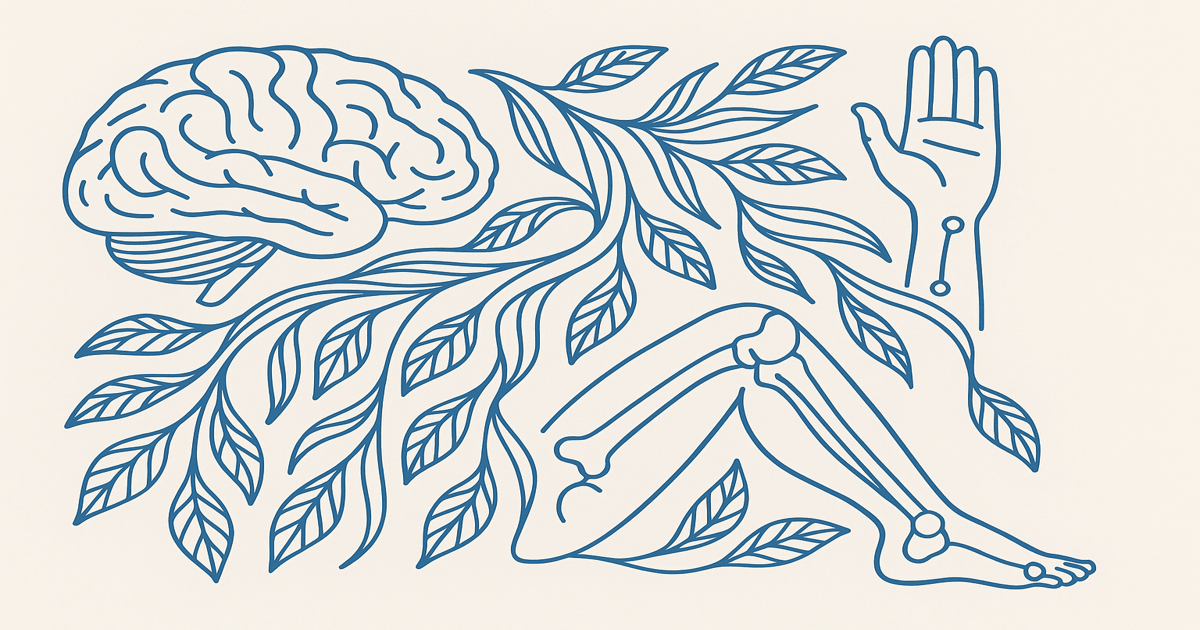It is becoming more widely acknowledged that some people with autism or ADHD also live with unusually flexible joints, ongoing pain, or difficulties such as dizziness and fatigue. Over the past two decades, research has been steadily uncovering connections between neurodivergence and hypermobility.
In this piece, I’ll walk through what’s been found, where the evidence is weaker, and how recognising these links may help us to care for both body and mind.
What the Research Shows
- Systematic reviews and meta-analyses confirm that people with autism or ADHD are more likely to meet criteria for generalised joint hypermobility (GJH) or related conditions.
- Observational studies show that, in clinical settings, neurodivergent groups are more likely to experience hypermobility, alongside autonomic issues and sensory or motor differences.
- General population studies don’t always show the same pattern, suggesting that the overlap is most obvious when symptoms are significant enough to bring people into clinics.
Making Sense of the Acronyms
- JH: Joint Hypermobility — when joints move beyond the expected range.
- GJH: Generalised Joint Hypermobility — affecting multiple joints.
- HMS: Hypermobility Syndrome — an older term, now largely replaced.
- HSD: Hypermobility Spectrum Disorder — the current diagnosis for symptomatic hypermobility not meeting EDS criteria.
- EDS: Ehlers–Danlos Syndrome — a group of genetic connective tissue disorders.
- hEDS: Hypermobile Ehlers–Danlos Syndrome — the most common EDS subtype, involving hypermobility plus other systemic features.
Why the Link Appears Stronger in Clinical Groups
Researchers highlight a few reasons:
- How hypermobility is measured: clinical exams tend to capture more cases than questionnaires.
- Symptomatic cases are over-represented in clinics: people experiencing pain, fatigue, or dizziness are more likely to seek help.
- Help-seeking bias: those with both neurodivergence and hypermobility are more visible in clinical studies.
- Age and sex factors: hypermobility is more common in younger people and in women, which shapes the findings.
Is There a Direct Biological Link?
No single biological pathway explains why neurodivergence and hypermobility often co-occur. But overlapping themes include:
- Autonomic regulation — difficulties with heart rate, blood pressure, and dizziness appear in both groups.
- Proprioception and motor control — differences in body awareness and balance may increase joint strain.
- Connective tissue and extracellular matrix biology — molecules that support joints also play a role in brain development.
- Developmental regulation — altered timing in nervous system development, beginning before birth and continuing after.
At this stage, the relationship looks more like association than causation.
How Understanding Helps People
Even without a proven causal link, recognising the overlap has practical value.
Autonomic Regulation
- Monitor for dizziness, fatigue, or rapid heart rate.
- Lifestyle strategies: good hydration, increased salt (if safe), compression garments, and gradual activity.
- Breathing practices and pacing can support the nervous system.
- Specialist medical care may be needed in some cases.
Sensorimotor Rehabilitation
- Physiotherapy to strengthen stabilising muscles.
- Balance and proprioceptive training.
- Occupational therapy where motor control affects daily life.
- Adapted sessions for neurodivergent people — structured, shorter, sensory-friendly.
Psychological Support
- Pain and fatigue can worsen anxiety and low mood; understanding the biology helps reduce self-blame.
- Cognitive-behavioural or acceptance-based therapies tailored for chronic symptoms.
- Neurodiversity-informed adaptations in therapy: clear structure, visuals, sensory accommodations.
- Peer support for validation and reducing isolation.
Looking Ahead
Future research priorities include:
- Long-term studies tracking development over time.
- Genetic and molecular research into shared pathways.
- Consistent diagnostic standards for both hypermobility and neurodivergence.
- Integrated trials testing combined physical, autonomic, and psychological care.
Final Reflections
Neurodivergence and hypermobility frequently overlap, but current science suggests this is not because one directly causes the other. Instead, both may arise from shared vulnerabilities in systems that shape development of both brain and body.
By recognising the overlap, we open the door to better care — reducing stigma, tailoring support, and helping people manage the realities of both their physical and psychological health.
In this video, Dr Jessica Eccles’ latest findings shed light on the intricate links between neurodivergence, inflammation, and hypermobility. The title is written for impact, but the video itself contains useful insights.
References
Baeza-Velasco, C., Vergne, J., Poli, M., Kalisch, L., & Calati, R. (2025). Autism in the context of joint hypermobility, hypermobility spectrum disorders, and Ehlers–Danlos syndromes: A systematic review and prevalence meta-analyses. Autism, 29(8), 1939-1958. https://doi.org/10.1177/13623613251328059 (Original work published 2025)
Kennedy, Matthew, Loomba, Katherine, Ghani, Hira and Riley, Bernadette. “The psychological burden associated with Ehlers-Danlos syndromes: a systematic review” Journal of Osteopathic Medicine, vol. 122, no. 8, 2022, pp. 381-392. https://doi.org/10.1515/jom-2021-0267
Glans MR, Thelin N, Humble MB, Elwin M, Bejerot S. The Relationship Between Generalised Joint Hypermobility and Autism Spectrum Disorder in Adults: A Large, Cross-Sectional, Case Control Comparison. Front Psychiatry. 2022 Feb 8;12:803334. doi: 10.3389/fpsyt.2021.803334. PMID: 35211037; PMCID: PMC8861852.
Glans M, Bejerot S, Humble M, Elwin M, Thelin N. Association between adult adhd and generalised joint hypermobility, with and without systemic manifestations: A case-control study. Eur Psychiatry. 2021 Aug 13;64(Suppl 1):S89. doi: 10.1192/j.eurpsy.2021.263. PMCID: PMC9471100.
Glans M, Bejerot S, Humble MB. Generalised joint hypermobility and neurodevelopmental traits in a non-clinical adult population. BJPsych Open. 2017 Sep 27;3(5):236-242. doi: 10.1192/bjpo.bp.116.004325. PMID: 28959454; PMCID: PMC5615214.
Kindgren, E., et al. (2021) ‘Hypermobility spectrum disorders and hypermobile Ehlers–Danlos syndrome in children: Neuropsychiatric comorbidity and clinical implications’, Neuropsychiatric Disease and Treatment.
Cederlöf, M., Larsson, H., Lichtenstein, P., Almqvist Malmros, C., Serlachius, E. & Ludvigsson, J. (2016) ‘Nationwide population-based cohort study of psychiatric disorders in individuals with Ehlers–Danlos syndrome or hypermobility syndrome and their siblings’, BMC Psychiatry, 16. doi:10.1186/s12888-016-0922-6.
Csecs JLL, Iodice V, Rae CL, Brooke A, Simmons R, Quadt L, Savage GK, Dowell NG, Prowse F, Themelis K, Mathias CJ, Critchley HD, Eccles JA. Joint Hypermobility Links Neurodivergence to Dysautonomia and Pain. Front Psychiatry. 2022 Feb 2;12:786916. doi: 10.3389/fpsyt.2021.786916. PMID: 35185636; PMCID: PMC8847158.
Casanova EL, Baeza-Velasco C, Buchanan CB, Casanova MF. The Relationship between Autism and Ehlers-Danlos Syndromes/Hypermobility Spectrum Disorders. J Pers Med. 2020 Dec 1;10(4):260. doi: 10.3390/jpm10040260. PMID: 33271870; PMCID: PMC7711487.
